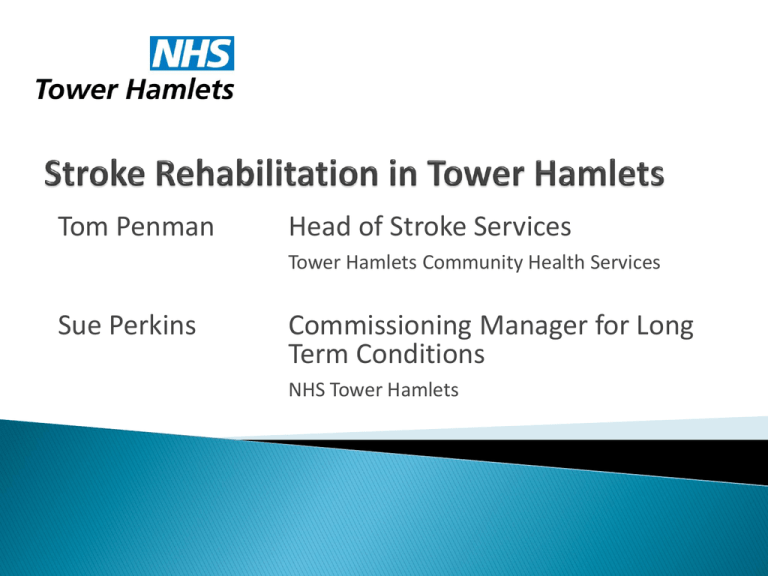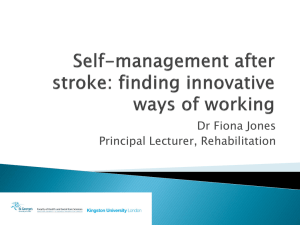Community rehabilitation best practice
advertisement

Tom Penman Head of Stroke Services Tower Hamlets Community Health Services Sue Perkins Commissioning Manager for Long Term Conditions NHS Tower Hamlets Every PCT should commission a community rehabilitation service for stroke patients delivered by staff with stroke specialist skills Service configuration should be locally determined and the service must meet all of the performance standards ▪ ▪ ▪ ▪ ▪ ▪ ▪ ▪ Tower Hamlets demographics … Deprived Overcrowded Diverse Young Growing population High unemployment 20% families live on less than £15,000 And our health our needs assessment tells us … ▪ Low life expectancy ▪ Health inequalities (male life expectancy vs national average) ▪ High burden of cardiovascular disease ▪ Health inequalities within the borough But … ▪ Ranked 1st nationally for economic growth Health Needs Assessment – Stroke in North East London ▪ Approx 2,000 residents on GP stroke registers ▪ Absolute number of deaths from stroke low compared to London (young population)..but.. ▪ Deaths in under 75s (“preventable”) from Stroke third highest in London ▪ Death rates in under 65s fourth highest in London ▪ Highest hospital admission rates for Stroke in London Parts of the jigsaw in place in 2008 Agreed, mapped Stroke pathway Service development & innovation driven by staff • Staff working across acute and community pathway • Inpatient community rehabilitation ward • Multi-disciplinary Community Stroke Team (CST) established Stroke a priority area - Commissioning Strategic Plan Missing pieces 1. Capacity of CST and inpatient rehabilitation 2. Accountability for stroke pathway 3. Clear service specification for community rehab team and structured Performance Monitoring process 4. Ongoing patient and public involvement 5. Clear link to prevention Post discharge 12 week input Team Manager 0.5 WTE Bengali Therapy Link Worker Occupational Therapist B7 Occupational Therapist B6 Physiotherapist B7 Physiotherapist B6 Clinical Psychologist 0.6 WTE Speech & Language B7 part-time Therapy Assistant B3 Consultant Junior Dr FY2 Registrar Nursing (not all stroke specialist) Speech and Language Therapy Occupational Therapy Psychology & Dietician Physiotherapy Some staff shared across Acute Stroke Unit, or across Older People’s Ward, or all Community Intermediate Care & Rehab services Further pathway review From patient perspective & against Stroke Strategy Stakeholder involvement Staff interviews, ward observations, discovery interviews, Local Authority engagement To develop a “vision” for the service Skill mix review Identified need for more specialist nursing staff & nursing clinical leadership role JSNA To add to PHAST data re. admissions, expected prevalence, current inequalities Investment and redesign needed Early Supported Discharge Pathway available to stroke survivors without an acute admission Post 12 week follow up Specialist vocational rehab service POST RATIONALE Head of Stroke Services, ClinicalManagement Nurse Head of Stroke Services accountability for stroke Specialist – leadership and management pathway, service development, strategic accountability leadership Clinical Nurse Specialist Clinical leadership across acute, inpatient rehabilitation and community Patient Facilitator & Family Support Worker Champion stroke survivor, family, carer voice Guide through pathway Non clinician point of contact ESD team Physio, OT, Speech & Language, RSW, Dietitian Appropriate frequency & intensity of rehab 7 day a week service Health and social care interventions ESD to target 20% of admissions Vocational Rehabilitation Support for people to remain in, or return to work or meaningful occupation Quality & Outcomes Patient / User Experience Performance & Activity Staffing Statutory compliance Service Specific criteria • Maximum time a patient waited for 1st clinical contact • % of clients with goals / care plans agreed • % appointments cancelled by the service • % seen within 30 mins of appointment time • # of referrals and discharges • # of clinical and non-clinical contacts • % of vacancies • % of staff up to date with safeguarding children and adults training • Use of London Stroke Strategy measures • # patients being case managed Agreed patient pathway From prevention, through acute, out to community, ongoing care Performance Management process Performance Dashboards, quarterly reviews for CST and inpatients HfL performance monitoring link Important for multidisciplinary teams working across a number of settings Role of CHD Nurse Specialists and Vascular Strategic Board Department of Health new contract template Governance structure Link to Prevention Clear Service Specification How to commission for a pathway rather than for a care setting Where does community rehab start and stop e.g. in-reach How to capture data for performance monitoring The role of Local Authority commissioner and LA Stroke funding How to engage primary care in what we develop How to “share” savings in social care package costs Where does community rehab start and stop e.g. in-reach How to capture data for performance monitoring The role of Local Authority and / or third sector providers Who manages new posts across disciplines e.g. Rehab Support Workers How to engage primary care and the role of GPs in rehab Can we combine unidisciplinary budgets for a multidisciplinary service How does the service work with more general reablement teams Additional resources sometimes distract from bigger issues Transitions can be improved (acute to community and community to long term support) without investment Stroke Networks have information about best practice Important to engage GPs – 12 month follow up Be clear what you want to commission (service specification) Meaningful PPI is difficult in short timescales and needs to be embedded in whole process Establish an explicit performance management process







